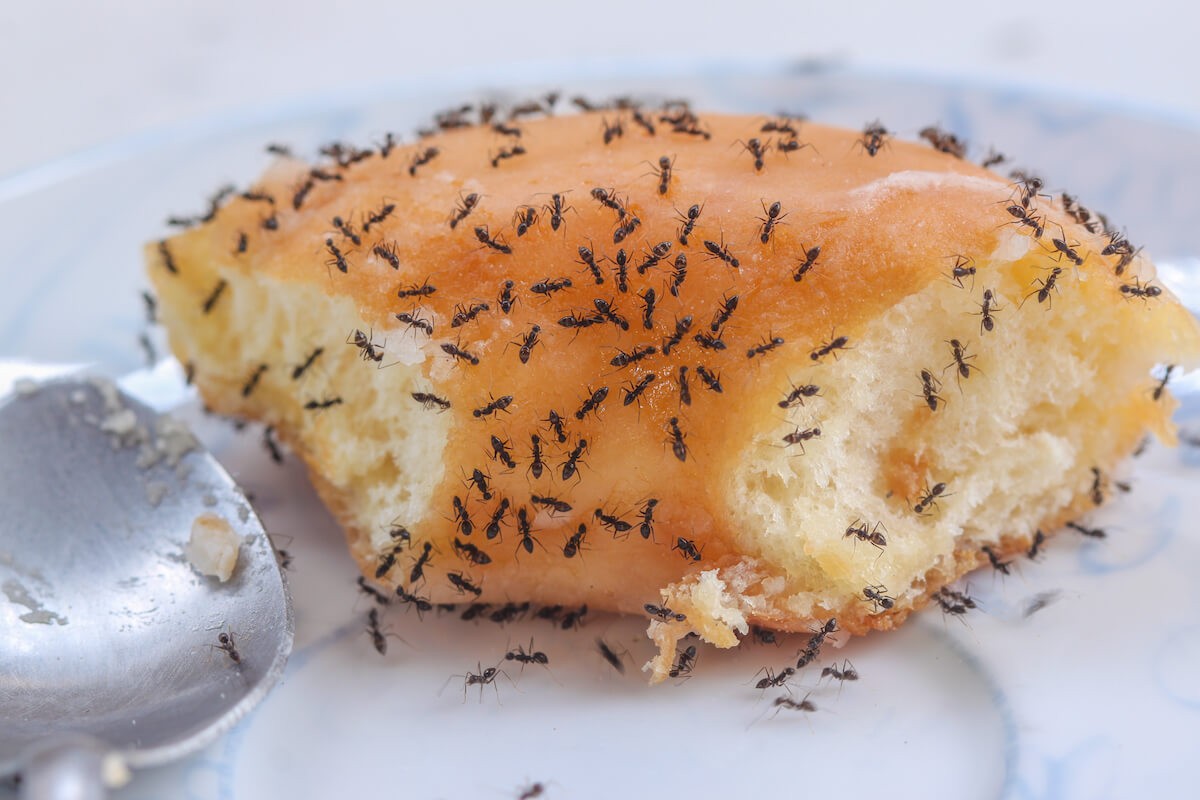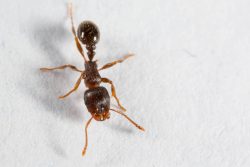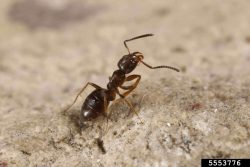What is the Most Common Ant in Utah?
By Thorn Team • Apr 5th 2022
North American pavement ants (Tetramorium immigrans) are the most common ants found in Utah. Previously referred to as Tetramorium caespitum, their activity is primarily found outside where they leave little piles of sand around patios, sidewalks, paving stones and driveways. While pavement ant workers are capable of biting and stinging, they are not aggressive and do not cause pain like other ants can.

North American pavement ants (Tetramorium immigrans) are the most common ants found in Utah. Previously referred to as Tetramorium caespitum, their activity is primarily found outside where they leave little piles of sand around patios, sidewalks, paving stones and driveways. While pavement ant workers are capable of biting and stinging, they are not aggressive and do not cause pain like other ants can.
Pavement ants often invade buildings in search of food and will feed on just about anything. Their damage is primarily cosmetic but they can be a real bother around homes and businesses, especially in the kitchen. How do you keep pavement ants away from your Utah home or business? Read on for a quick pavement ant identification and treatment guide.
How to Identify Common Pavement Ants in Utah
Whether you live in Utah or not, ants are common household pests that can be difficult to get rid of. Identification and assessment is the first and most important step in developing a pest control treatment plan, but how do you tell what type of ant you're dealing with when they're so small and hard to see?
Pavement ants get their name from their habit of building their nests in cracks in sidewalks, driveways and other similar places. Oftentimes, the first noticeable sign of pavement ant activity are small piles of sand along the driveway or sidewalk or ants congregating along patio crevices.
Pavement ants have the following characteristics:
- Small, about 1/8 inch long
- Light brown to black body color
- Six legs that are slightly lighter than their body
- have two nodes, or bumps, on their body
DEFINITION: Petiole nodes (nodes for short) are the number one thing to look at when identifying ants. Nodes are located on the first segment of an ant's abdomen. Ants have either one or two nodes, and pavement ants have two. Knowing this can help you tell pavement ants from the ants they are most commonly confused with, including the odorous house ant.
Pavement Ants vs. Odorous House Ants - What's the Difference?
Pavement ants are commonly confused with other ants, especially the odorous house ant. There are some key differences in these species, including the distinct smell odorous house ants (OHAs) release when they are crushed.
Pavement Ants
|
Odorous House Ants
|


If you are located in Utah and you're having difficulty further identifying your ant problem, please don't hesitate to reach out to us! Our specialists at Thorn would be happy to help identify your ant issue and formulate a treatment plan to keep ants out of your spaces.
For more help identifying between species of ants, visit the Thorn Pest Library where you can find additional pictures and identification information.
Ants with Wings - Spring Pavement Ants in Utah
Spring is the time for pests in Utah, especially pavement ants.
Pavement ant swarmers are active in Utah during the spring months. A swarmer is a winged ant that is part of the reproductive cycle of many ant species, including pavement ants. If it's spring time and you're seeing small, black, winged ants around your property, try not to panic, but do keep an eye on things.
Pavement ant swarmers are most likely to be seen on warm days that arrive suddenly just after a cold or rainy spell. If, in a couple of days, the activity you're seeing hasn't died down, start keeping your eyes open for other signs of pavement ant activity.
How to Get Rid of Pavement Ants
Before starting ant control, it's important to remember that ants (like many other pests) play an important role in many ecosystems. They perform a variety of beneficial functions, including:
- Enriching and aerating the soil
- Breaking down organic matter
- Dispersing seeds
- Controlling other insect pests
- Pollination
Ants may be small and annoying creatures, but keep in mind that outside, they are performing many valuable services for the environment. If there are pavement ants in your kitchen or causing problems in your garden, that's a different story.
Balance is important, and effective pest control seeks to keep pests outside, where they can perform their beneficial functions without getting into your things and causing you trouble.
SOME QUICK ADVICE FROM THORN: Certain issues can and should be handled by the homeowner or business operator, but when it comes to controlling ants with pesticide, we recommend you look for a company that specializes in IPM. They will identify what ant you're dealing with and treat according to the species present. Handling an ant problem improperly can make certain issues worse in the long-term, and IPM specialists have many tools available for the control of pests that involve little to no chemical at all.
If you think your pest issues may require chemical treatment, call a professional to help, and if you're in Utah, call Thorn Pest Solutions. We'll get those pesky ants taken care of promptly and with utmost professionalism.
3 Things You Can Do TODAY to Get Rid of Pavement Ants
When it comes to managing pests, it's important to approach things from an Integrated Pest Management (IPM) perspective, with assessment and identification being the first and most important step in the process. If the species of ant is unknown, the problem may be handled incorrectly, which can make long-term management more difficult.
If you're having trouble further identifying what type of ants you're dealing with, visit our ant library for more pictures and information. Still can't tell? Contact a local pest control company that specializes in IPM, and if you're in Utah, that's Thorn!
1. Remove Conducive Conditions
Once you've properly identified the species of ant you're dealing with, it's time to identify what conducive conditions are present. In pest control, a conducive condition is anything that could be attracting the ant to your space.
With pavement ants, removal of conducive conditions can seem complicated because you probably don't want to go tearing out patios and walkways all over the place.
Seek to reduce the pavement ants you're seeing inside. Aim to keep pavement ants outside when you can. Afterall, they may be obnoxious but they're also beneficial.
Consider the following:
- Where are the ants are feeding?
- Where are the ants are coming from?
Pavement ants will eat a variety of things including insect parts, pollen and honeydew from aphids. Inside, they prefer sweet and greasy food sources including food crumbs and cooking residue. Keep this in mind while you're investigating your inside spaces.
When it comes to nesting sites, there are some typical nesting locations where pavement ants like to set up camp:
- Under rocks, lawn ornaments, logs, pavers, patios and mulch
- Beneath bathtubs, toilets, carpets and trashcans
- Inside insulation, foundation cracks, false ceilings, and wall voids
- In gardens, woodpiles, and turfgrass
- Near water or termite damaged wood
- Around radiators, bathrooms, sliding glass doors, and window or door frames
If the nest is close to the house (or in the house) it may be difficult to eradicate pavement ants without professional pest control services. Look for a local company that specializes in Integrated Pest Management.
2. Place Bait for Pavement Ants
According to the EPA, you should never use over-the-counter sprays and baits together when trying to control pests on your own.
Here at Thorn, we're going to take it one step further and say that if you're feeling the need to try and remedy a pavement ant situation on your own before calling out a pest management professional, opt for over-the-counter baits only. Stay away from the sprays.
There are a couple of reasons for this:
1. Sprays can make certain ant issues worse. Ant identification can be tricky, and pavement ants are frequently be confused with odorous house ants (OHAs). If your pavement ant issue is actually an OHA issue, an over-the-counter spray could cause the colony to fracture, causing the problem to get bigger over time.
2. Less Risk. Baiting can be quite simple. You open the bait station and you put it in place. A spray is much more complicated and comes with more risk of injury and damage to the environment if improperly applied.
SOME QUICK ADVICE FROM THORN: When placing baits, remember that baits are sweet and will draw trailing ants to them. This means you may not want to place ant bait stations in high traffic areas. For example, if you're seeing ants on your kitchen counter, find where they are trailing from. If you're finding trails inside a drawer or under the sink, put your bait station there where it will be hidden and allow ants to feed on it where you can't see them doing their creepy-crawly business.
Also bear in mind that the baits available at the hardware store are different than the baits available for professional pest control use. If your goal is to allow ants to do their thing but to keep them out of sight, self-baiting may be a good option. If eradicating the ants from your inside areas is the goal, it's definitely best to call in the pros.
3. Call A Pest Control Specialist
Ant control can be complicated, but a well-trained pest professional makes it simple. They'll know what to look for and what to do (or not to do) to get control of pavement ants.
Make sure the company you are hiring is state licensed and insured, and make sure they take their training seriously. Look for companies involved with organizations such as the NPMA (National Pest Management Association).
Pest control is an ever-growing, always changing field. Staying up-to-date on the latest pest control methods and trainings is very important when it comes to reducing risk and implementing efficient pest control strategies.
Get Rid of Common Pavement Ants in Utah
At Thorn, we're here to keep pests away from the places where you live, work and play.
While pavement ants may not be a major health concern, they can be a serious every-day nuisance. Handling a pavement ant issue isn't just about controlling ants, it's about bringing peace to our customers.
With a QualityPro certification awarded to less than 3% of pest control companies in the U.S., Thorn Pest Solutions takes pest control seriously, and for us, that starts with the relationships we build with our customers.
If you're spotting pesky pavement ants around your home and you're located in Utah, we'd love to hear from you! We'll help you identify your ant issue, assess the circumstances, and come up with a plan to keep them away for good.
About Thorn
Thorn is a Utah local pest management company. We are a QualityPro certified company which is a prestigious accreditation awarded too less than 3% of the pest management companies in the US.
Resources
About Thorn
Thorn is a Utah local pest management company. We are a QualityPro certified company which is a prestigious accreditation awarded too less than 3% of the pest management companies in the US.